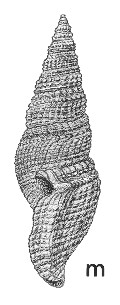
Revised descriptions of New Zealand Cenozoic Mollusca from Beu and Maxwell (1990)

 | Revised descriptions of New Zealand Cenozoic Mollusca from Beu and Maxwell (1990) | 
|
  (Pl. 49m): GS4102, R22/f6516, Tainui Shellbed, Castlecliff, Wanganui, Castlecliffian (GNS) |
Beu & Maxwell (1990): Chapter 16; p. 367; pl. 49 m.
Synonymy: Pleurotoma rosea Quoy & Gaimard 1833, p. 524; Pleurotoma novaezelandiae Reeve 1843 (in 1843-1846), pl. 17, fig. 143; Drillia novaezelandiae; Phenatoma novaezelandiae
Type species of Phenatoma Finlay, 1924
Classification: Conidae: Borsoniinae(?) ("Clathurellinae", clade 15?; Puillandre et al. 2008)
Description: Largest of New Zealand Pleistocene-Recent common shallow-water Turridae (25-38 mm high), tall and narrow, with tall, weakly stepped spire (1.3 times height of aperture and canal), and short, widely open, very weakly twisted but deeply notched anterior canal with low, rounded fasciole. Whorls weakly angled at lower margin of sinus trace high on spire, but angulation fading out down shell, last whorl evenly convex. Sculpture of many low, wide, flat-topped spiral cords, 6 or 7 on sides of spire whorls but becoming subdivided by median groove and intercalating secondary threads on last whorl, last whorl with more than 20 closely crowded cords. Many narrow axial grooves cut cords into flattened rectangular nodules. Aperture simple, with thin lips; outer lip with moderately deep, narrowly U-shaped anal sinus occupying lower part of sutural ramp. Protoconch small, narrowly conical, of 3.5 smooth whorls, with a blunt apex.
Comparison: The second living species, Phenatoma zealandica (Nukumaruan?; Castlecliffian-Recent), occurs with but is less common than P. rosea at Castlecliff; it is shorter and wider than P. rosea, lacks obvious axial sculpture, and has fewer spiral cords, but has a wide, smooth, median zone on the last whorl. P. zealandica appears to be descended from P. precursor (Mangapanian-Nukumaruan) which is smaller and has more numerous spiral cords than P. zealandica. P. rosea is considerably larger and has more numerous spiral cords and less angled whorls than its presumed ancestor, P. decessor (Waipipian; Pl. 37w). Older species are discussed under P. decessor.
Distribution: Mangapanian-Recent; Recent, New Zealand (types of Pleurotoma rosea and Pleurotoma novaezelandiae); moderately common throughout New Zealand at present in shallow water on large sand flats (notably near Collingwood, Golden Bay, western Nelson) and cast ashore on sand beaches; common in shallow-water sandstone and some offshore siltstone beds (notably Kupe Formation and Tainui Shellbed) at Castlecliff, Wanganui; less common in a wide range of shallow-water facies throughout New Zealand late Pliocene and Pleistocene rocks.
Cite this publication as: "A.G. Beu and J.I. Raine (2009). Revised
descriptions of New Zealand Cenozoic Mollusca from Beu and Maxwell (1990). GNS
Science miscellaneous series no. 27."
© GNS Science, 2009
ISBN
978-0-478-19705-1
ISSN 1177-2441
(Included with a PDF facsimile file
copy of New Zealand Geological Survey Paleontological Bulletin 58 in CD version
from: Publications Officer, GNS Science, P.O. Box 30368 Lower Hutt, New
Zealand)